After the age of 35, NAD+ levels decline, and the four major crises of premature aging in women break out simultaneously, with the rate of ovarian aging significantly accelerating!
NAD+ and Premature Aging in Women: A New Perspective
The latest research has found that after the age of 35, many women will simultaneously encounter a set of "concurrent problems" - unstable menstrual cycles, loose and dry skin, slow recovery after staying up late, and difficulty waking up at night. In the past, people often simply attributed these phenomena to "reaching a certain age".
In recent years, multidisciplinary research has focused on the same molecular switch - NAD+ (nicotinamide adenine dinucleotide).
NAD+ is an essential factor for core responses such as energy metabolism, DNA repair, and epigenetic regulation.
Multiple human and animal evidences show that with age, NAD+ levels in tissues and cells generally decline and change in the same direction as multiple aging-related phenotypes.

Further mechanism research suggests that ovarian aging, skin structure and function degradation, circadian rhythm disorder, and DNA damage accumulation can be interlinked through NAD+ gaps.
NAD+ : core of cellular energy and repair
NAD+ is one of the most common coenzymes in cells, running through the oxidation of glucose and fat, the tricarboxylic acid cycle and the mitochondrial electron transport chain, and is the electron carrier for ATP generation.
It is also the substrate of longevity proteins (Sirtuins) and PARP family repair enzymes, participating in key processes such as DNA damage perception and repair, and epigenetic homeostasis.

NAD+ not only maintains the "energy ledger" but also provides raw materials for "genome maintenance".
During the aging process, the imbalance at both the synthesis and consumption ends drives down NAD+ : at one end, the efficiency of synthetic pathways (such as NAMPT-mediated resynthesis) declines;
The other end is the consumption end (such as PARP activation driven by inflammation and DNA damage, and immune-related NADase such as CD38) enhancement.
A systematic review indicates that this decline in human-mouse consistency across multiple tissues is associated with various phenotypes such as neurodegeneration, metabolic disorders, sarcopenia, and fragile syndrome.
There is also direct evidence from population and tissue samples: the NAD+ content in the skin, liver, skeletal muscle, cerebrospinal fluid and peripheral blood decreases with age (mostly accelerating after middle age).
This quantitative gap is not merely an "indicator", but will also transform into a systemic functional gap resulting from insufficient energy supply, reduced repair capacity and increased oxidative stress.
four major NAD+ mechanisms of premature aging in women
1) Ovarian function and reproductive aging
The ovary is regarded as one of the earliest organs to enter aging.
Mouse models showed that with age, the levels of NAD+ and NAD(P)H in oocytes decreased, and mitochondrial activity and the stability of the meiosis spindle were impaired.
Supplementing NAD+ precursors (such as NMN) can to a certain extent improve the quality of oocytes and the rate of embryo development.
At the mechanism level, inflammation-driven upregulation of CD38 can accelerate the consumption of NAD+ in the ovaries and reduce follicular reserve.
Gene knockout or pharmacological inhibition of CD38 can alleviate ovarian aging and improve fertility in mice.
2) Skin structure and barrier function
The energy metabolism and repair of skin cells are highly dependent on NAD+.
In randomized controlled trials, oral administration of nicotinamide (a type of NAD+ precursor) can reduce transdermal water loss (TEWL) and improve barrier function.
In Phase III RCTS of high-risk populations, oral niacinamide can reduce the incidence of new-onset non-melanoma skin cancer and photoactinic keratosis, suggesting its clinical significance for DNA repair/immune regulation after ultraviolet damage.
Although these studies do not directly equate to the cosmetic conclusion of "anti-wrinkle/firming", they provide verifiable human evidence in the dimension of "repair - protection - function".

3) Circadian Rhythm and Sleep
NAD+ plays the role of a "gear lubricant" in the circadian rhythm: the core CLOCK complex CLOCK/BMAL1 and SIRT1-NAMPT-NAD + form a feedback loop.
The decline of NAD+ can reduce the activity of SIRT1, affecting the synthesis of melatonin and the homeostasis of multiple organ rhythms, which is manifested as difficulty falling asleep, waking up at night, and feeling weak in the morning.
Restoring NAD+ or up-regulating NAMPT can restructure the amplitude and phase of the rhythm.
4) DNA damage and genomic stability
DNA break repair requires PARP to perform ADP-ribonylation labeling with NAD+ as the substrate. Extensive oxidative stress can trigger a chain reaction of PARP overactivation - NAD+ depletion - impaired SIRT1 activity, leading to delayed repair and an increased probability of mutation accumulation.
Cell-level experiments have confirmed that DNA damage within the nucleus can rapidly trigger whole-cell NAD+ depletion.
This link aligns with the molecular basis of aging, metabolic diseases, and certain tumor risks.
NAD+ intervention: Benefits from Organs to Systems
Regarding the key demands of premature aging in women, the current evidence shows a hierarchical consistency from animals to humans and from mechanisms to preliminary clinical manifestations in the four dimensions of "ovaries - skin - rhythm - metabolism".
Ovarian/Fertility dimension:
In the natural aging and chemotherapy-induced damage model, NMN supplementation enhanced oocyte quality and increased the achievement rate of embryonic development milestones, suggesting that functional backfilling could be achieved through the pathway of "improving ovarian NAD+ availability - enhancing mitochondrial function - reducing spindle abnormalities/aneuploidy".
Skin dimension
Human RCT of oral nicotinamide showed improved barrier function and a reduced incidence of ultraviolet-related lesions.
This is in line with the chain of "increasing NAD+ - enhancing DNA repair - reducing inflammatory response" in basic research, which can be translated into indirect benefits for functional problems such as dryness, redness and susceptibility.
Sleep/rhythm dimension
Animal and cell studies suggest that increasing NAD+ or activating SIRT1/NAMPT can stabilize the oscillations of circadian rhythmic-related genes, providing molecular explanations and intervention clues for common rhythmic disturbances in middle age.
metabolic dimension
In studies on mice and early humans, NAD+ precursors can increase NAD+, and in some studies, improvement trends in indicators such as glucose tolerance and blood pressure/arterial compliance have been observed.
This provides a mechanism basis and intervention target for the "post-meal drowsiness and metabolic disorders" that are common among middle-aged women.
Three pathways to increase NAD+
Path A: Dietary Nutrition and Lifestyle
B vitamins and foods rich in tryptophan/niacin (such as liver, fish, whole grains, dairy products, etc.) are the underlying supplies of the resynthesis pathway. However, the rate-limiting effect of NAMPT and individual differences determine that the increase in NAD+ by diet alone is limited.
Its value lies more in safeguarding the bottom line and coordinating with other paths.
Exercise combined with time-restricted eating (TRF/ intermittent light fasting) is expected to generate "physiological gains" by up-regulating NAMPT - boosting Sirtuins activity. It is a medium - to long-term, low-risk, and sustainable approach.
Path B: Oral Precursors (evidence-based subjects)
NR (nicotinamide riboside) : Human studies have shown that supplementation within 6 to 12 weeks can significantly increase NAD+ levels in blood cells or plasma, and in some studies/subgroups, improvement trends in cardiovascular-related indicators such as arterial stiffness and blood pressure have been observed.
NMN (Nicotinamide Mononucleotide) : Animal and early human studies suggest that it has potential benefits for metabolic indicators such as glucose tolerance and insulin sensitivity, and has shown signals of improved oocyte quality/embryo development in ovarian models.
Multiple registration clinical trials are advancing the validation of more populations and outcomes.
Path C: Exogenous NAD+ (ongoing research)
Exogenous NAD+ (including injection/infusion) serves as a direct supplementary pathway. The current main evidence comes from mechanism and small sample studies.
Compared with oral precursors, its accessibility, tolerability and long-term outcomes still require higher-quality clinical trials to clarify. Therefore, it should be regarded as an exploratory option and not be exaggerated.
Reference Materials
Covarrubias AJ, et al. Nature Reviews Molecular Cell Biology, 2021: A Review of NAD+ metabolism and Aging.
Massudi H, et al. PLoS ONE, 2012: The relationship between NAD+ and age in population/tissue.
McReynolds MR, et al. Ageing Research Reviews, 2020 (Review /PMC) : NAD+ decreases with age in human skin and CSF, etc.
Bertoldo MJ, et al. Cell Reports, 2020: NMN/NAD+ supplementation improves oocyte quality and fertility in mice.
Yang Q, et al. Nature Aging, 2024: CD38 mediates NAD+ depletion and ovarian aging.
Chen AC, et al. Br J Dermatol, 2016: RCT of oral nicotinamide in reducing TEWL.
Chen AC, et al. N Engl J Med, 2015: Oral nicotinamide reduces new-onset NMSC and AK (ONTRAC) in high-risk population.
Nakahata Y, et al. Science, 2009: NAMPT-NAD + -SIRT1 participates in the circadian rhythm feedback loop.
Murata MM, et al., 2019 (PMC) : DNA damage triggers PARP-dependent NAD+ depletion.
Trammell SAJ, et al. Nat Commun, 2016: Oral NR boosts NAD+ in human blood.
Martens CR, et al. Nat Commun, 2018: NR Boosts NAD+ in middle-aged and elderly populations and explores vascular indicators.
Yoshino J, et al. Cell metabolism, 2011: NMN improves glucose metabolism and insulin sensitivity in mice.
ClinicalTrials.gov: ongoing trials of NMN improving embryo development and IVF outcomes.
Conlon NJ, et al. Plast Reconstr Surg Glob Open, 2022: A Review of age-related decline of NAD+ in humans/multiple tissues and regenerative medicine.






